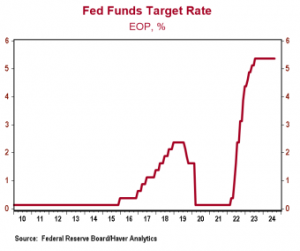Could this be the last Fed meeting before rate cuts begin? With inflation moderating and job growth weakening, the Fed prepared markets for a more eventful meeting in September while not committing to anything just yet.
The Fed’s statement included a number of changes, including language surrounding softening job gains, highlighting a higher unemployment rate, noting further progress on inflation, and changing language to note they are now focused on risks to both sides of their dual mandate (this text previously focused only on inflation risk). However, the Fed did keep language that they “do not expect it will be appropriate to reduce the target range until it has gained greater confidence that inflation is moving sustainably toward 2 percent.”

During the press conference, Powell was a bit more forthcoming. The very first question from a reporter asked if September is on the table, as markets are now pricing in a rate cut at the next meeting as a done deal. Powell confirmed that if data continues to show the progress it has of late, it may very well be appropriate to move as soon as the next meeting. In fact, Powell later stated that “a strong majority of members supported not moving at today’s meeting” showing that there was at least some discussion at this week’s meetings of starting rate cuts today.
Powell also spent time expanding on how the Fed views the balance of risks. As employment indicators have weakened, the Fed no longer sees the labor market as a source of higher inflation, and a material weakening in the labor market would now bring forward the potential for policy easing. In Powell’s words, “the downside risks to the employment mandate are now real.” It still appears the Fed is more worried about moving too soon rather than moving too late, but that too is coming into more even balance.
Fed confidence is growing, and easing looks on the horizon, but that doesn’t mean the job is done. There are a handful of reports on both inflation and employment to come between now and the September meeting, which could shift expectations just as reports did earlier this year. The Fed have been consistently following the wrong signals since the start; ignoring the growth in the M2 money supply in favor of blaming supply changes, which resulted in targeting a symptom rather than the disease. They flooded the system with excess reserves, muting their ability to manage economic activity through monetary policy and putting themselves in the awkward position of running large losses. They find themselves reacting to stubbornly high inflation they told us would be transitory, and constantly trying to explain away why their forecasts have been off base.
We do expect that the Fed will cut rates twice later this year, once in September and again in December, but we see these cuts accompanied by a slowing economy, higher unemployment, and modest progress on inflation. The morphine is wearing off and the aftereffects of money printing, excessive and misguided spending from Washington, and companies getting a bit over their skis in terms of hiring are starting to show.
Brian S. Wesbury, Chief Economist
Robert Stein, Deputy Chief Economist
Date: 7/31/2024



